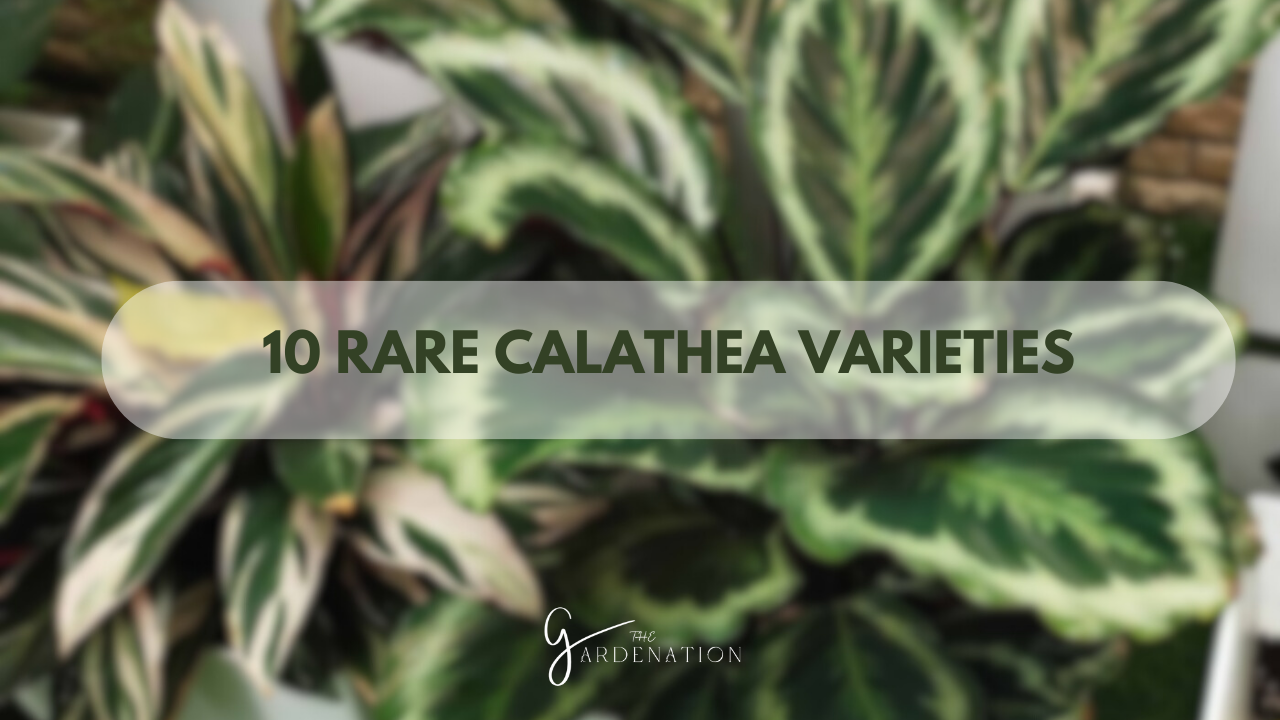10 Rare Calathea Varieties
Enchanting the indoor plant world with their ornate foliage, Rare Calathea species captivate collectors with their stunning diversity. Recent taxonomic discoveries have transformed my understanding of these plants, reclassifying many varieties into the new genus Goeppertia. This revelation carries significance for proper identification and care of rare types.
I have explored 10 scintillating Calathea rarities, from the flaming foliage of Calathea Veitchiana ‘Flamestar’ to the sublime symmetry of Calathea Warscewiczii. I have studied their distinguishing traits, cultivation needs, and the rewards of dedicating oneself to these capricious beauties. For devoted plant custodians like me, few joys surpass the flourishing of these botanical wonders.
Calathea Transformation
A 2020 phylogenetic study reclassified over 200 Calathea species into a new genus – Goeppertia. This adjustment acknowledged genetic divergence between this group and other Calathea plants. Enthusiasts must now distinguish between the two genera when identifying and labeling prized varieties.
The reclassification also impacts care requirements. Goeppertia species tend to demand more meticulous attention than their Calathea peers, needing strict humidity and brightness avoidance to showcase their elegance. By understanding this transformation of categorization, collectors can better provide the precision nurturing these elite plants desire.
Rare Calathea Overview
While all Calathea plants flaunt noteworthy features like color-changing foliage, some standouts draw particular admiration for their artful leaves and finicky cultivation needs. Termed rare Calatheas, these special varieties intrigue collectors with their showy forms and sensitivity to growing conditions. Their rarity originates from the mastery required to maintain their health and display their charming assets.
For devotees willing to pamper their exacting requirements, cultivating rare Calathea and Goeppertia varieties promises enormous rewards through glimpses of their ornate grandeur. But casual appreciators often find frustration with their demanding nature. Read on to discover 10 scintillating rare varieties for the bold and diligent gardener.
Rare Calathea Varieties
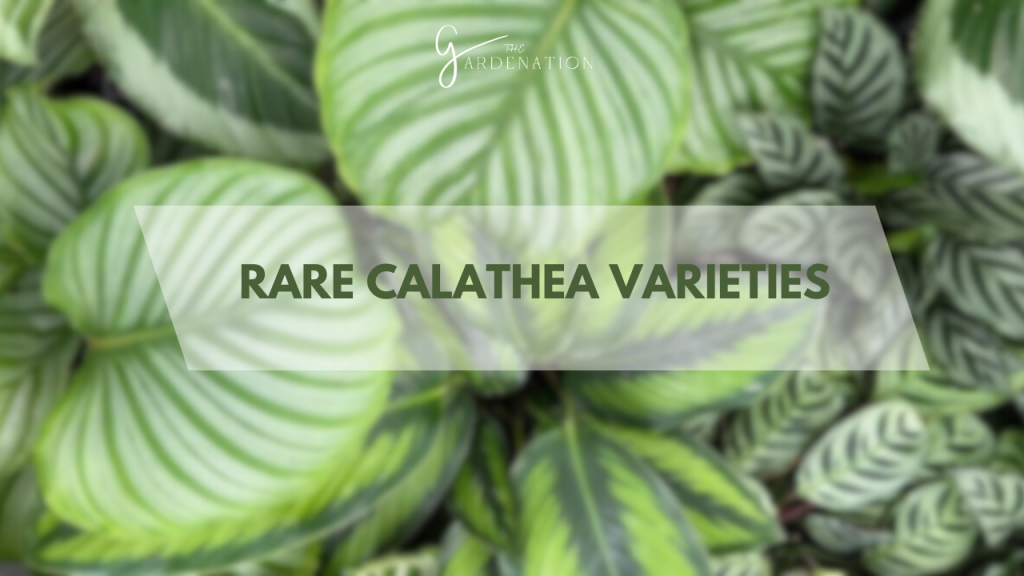
1. Calathea Veitchiana ‘Flamestar’
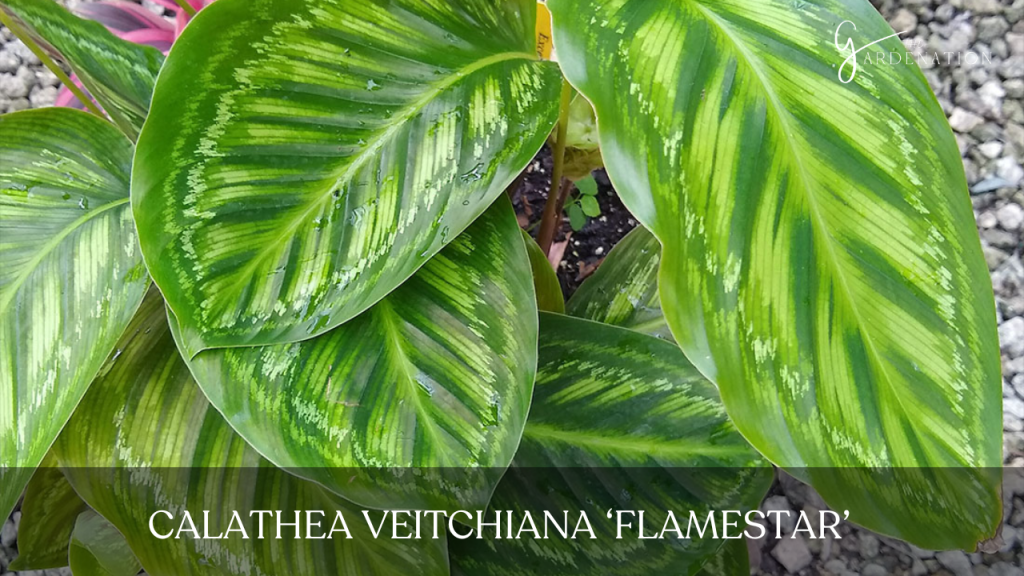
Native to the tropical Mata Atlântica rainforests of southeastern Brazil, Calathea ‘Flamestar’ enchants with its gently undulating leaves saturation in fiery tones. The wavy oblong leaves emerge a lush green before their undersides flush an intense red-orange. Dark purple stems and undersides highlight the neon colors, giving off the spectacular impression of holding flickering flames. This highly decorative effect persists under exacting care.
I provide bright filtered light to encourage coloring without direct sun scalding delicate leaves. I maintain high ambient humidity around 60% or higher. I water thoroughly when the top inch of soil dries out. I feed monthly during growth spurts with a balanced fertilizer and repot every 2-3 years to refresh soil nutrients.
2. Calathea Fucata
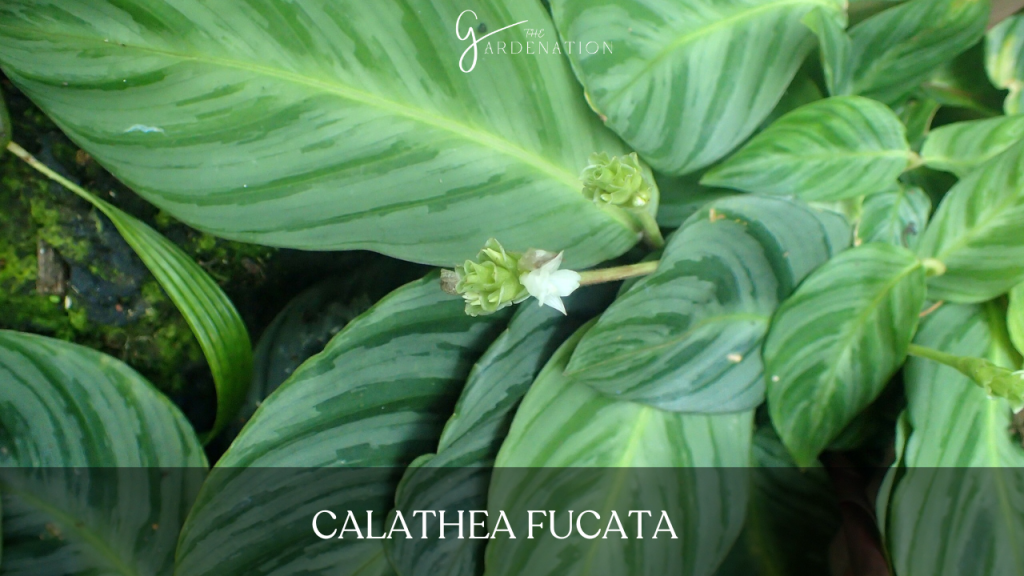
Hailing from the lush environs of Brazil, Calathea fucata mesmerizes with its vertical pinstripe patterned leaves in cool shades of green. Emerging foliage progresses from lime green to darker hunter green tones as leaves mature. The defining feature remains the deep green vertical stripes decorating each oblong wavy leaf, producing a dizzying hypnotic effect.
I give bright indirect light to encourage declaration of the striped patterns without risking leaf burn. I mist regularly and use pebble trays to provide ambient humidity around 50%. I water when the top inch of soil dries out. I wipe leaves periodically with damp cloth to prevent spider mites.
3. Calathea Pavonii
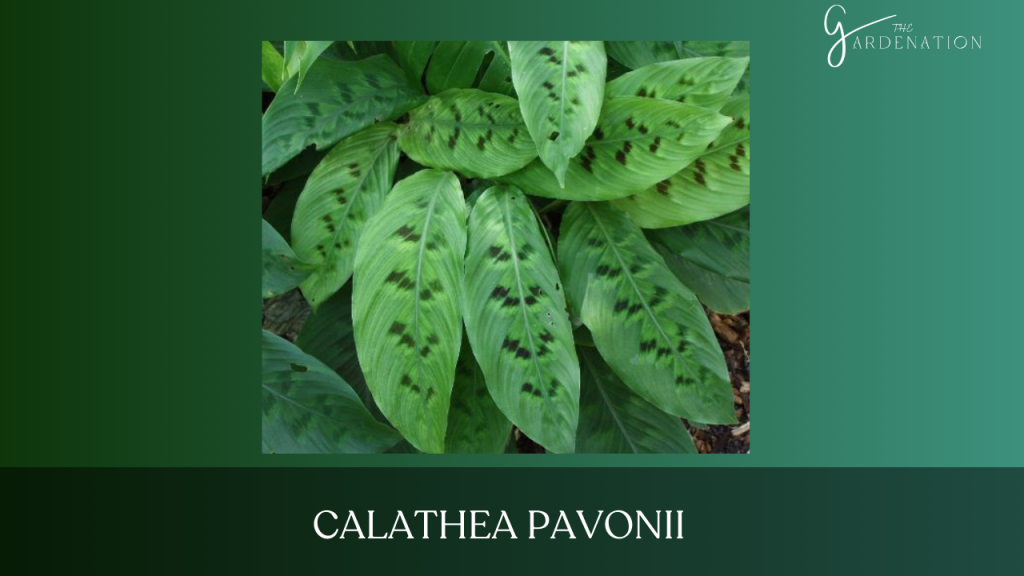
One of the rare bi-colored Calathea prayer plant cultivars, Calathea Pavonii unfurls captivating leaves colored forest green above and deep purple below. The contrast makes a dramatic statement. Glossy texture gives leaves an iridescent quality while wavy, twisting shapes impart movement. New growth emerges bright pink before darkening into maturity.
I site in bright filtered light and limit sun exposure to a couple hours daily. I maintain even moisture in the potting mix and mist regularly to provide needed humidity levels around 60%. I use distilled or rainwater to prevent leaf tip burn and blot off dust accumulating on the leaf surfaces to retain vibrant colors.
4. Calathea Cynthia
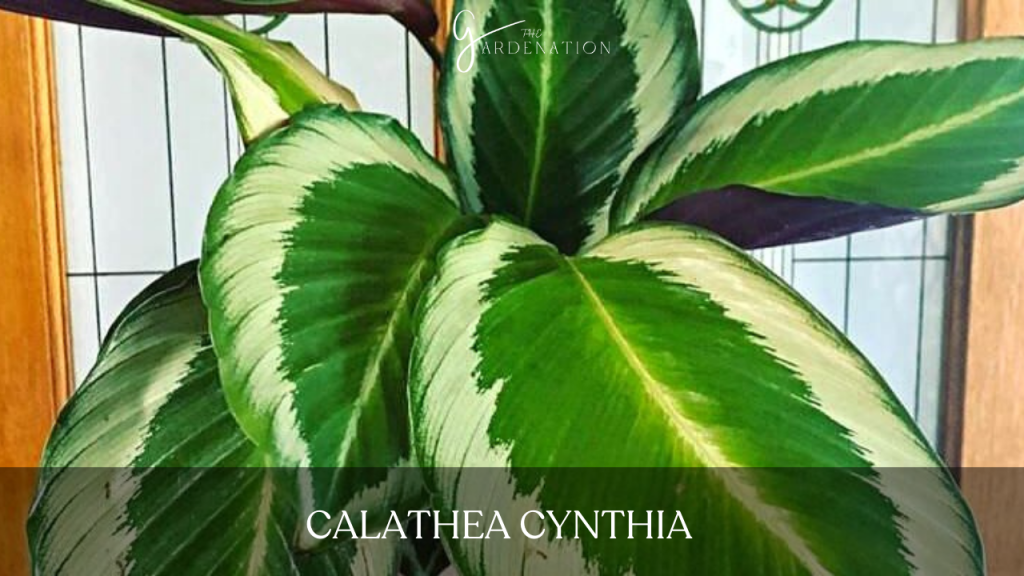
Bearing lustrous leaves decorated with dark brushstrokes against light green backgrounds, Goeppertia Cynthia makes a tropical statement wherever displayed. The elliptical leaves grow over a foot long, accented by red leaf stems. Growing wild as an understory rainforest plant, its natural habitat remains shaded and humid year-round. Recreating similar conditions keeps specimens glorious.
I provide bright indirect sunlight avoiding harsh direct sun rays. I maintain high humidity around 60% using misters and pebble trays with water. I water thoroughly allowing the soil to slightly dry between waterings, using rain or distilled water. I wipe leaves periodically with damp soft cloth and watch for pests like spider mites which can damage emerging growth.
5. Calathea Corona
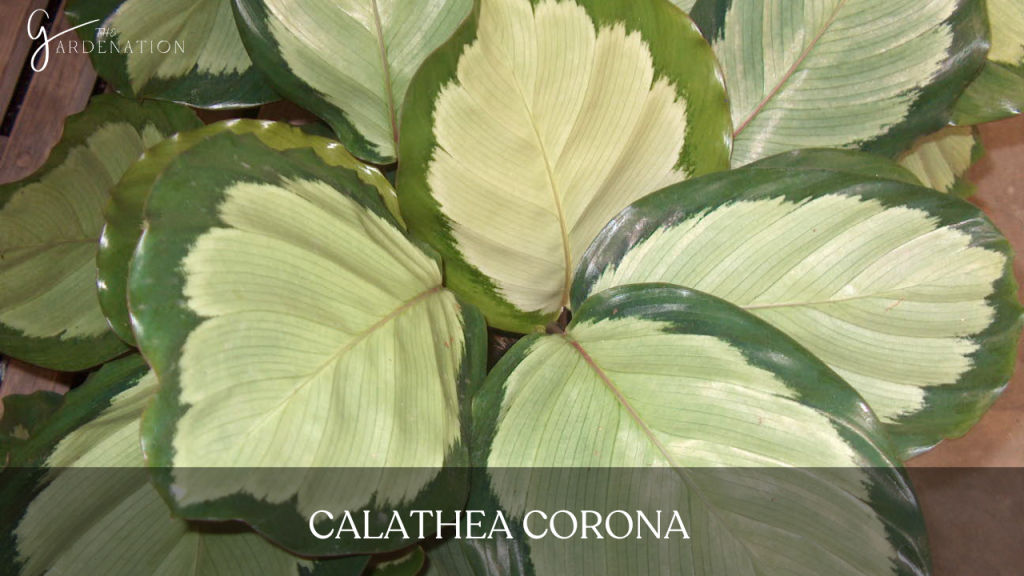
Earning a regal designation from its ornate foliage, Calathea Corona intrigues with rounded leaves encircled by a dark green ring right around the edge. This eye-catching border in deep emerald contrast against paler inner leaf sections creates lavish optical effects. Red stems and undersides also add dramatic contrast.
I provide bright filtered sunlight and temperatures between 60-80°F. I water thoroughly allowing soil to slightly dry before rewetting and mist often to provide ambient humidity around 60%. I feed monthly with a balanced fertilizer during growth seasons. I repot every 2-3 years using a well-draining potting mix amended with orchid bark.
6. Calathea Ornata
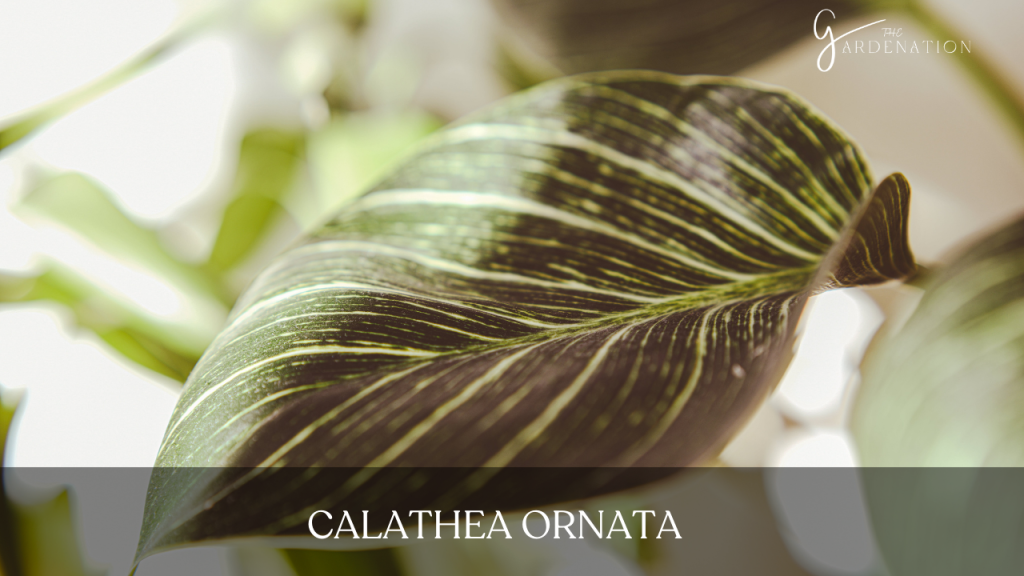
Arguably the most recognizable Calathea variety, C. ornata stands out through wavy leaves decorated by bright pink stripes drawing the eye. The dark green backgrounds allow the bubblegum pink pinstripes to pop despite variations in intensity across seasons. Red stems and undersides also intensify the foliage colors to eye-catching effect.
I give bright indirect sunlight avoiding direct sun exposure which burns delicate leaves. I provide supplemental humidity around 60% and evenly moist soil using rain or distilled water. Leaf curling indicates under watering. I monitor closely for spider mites which damage emerging growth. I maintain average room temperatures between 65-80°F for best health.
7. Calathea Margarita
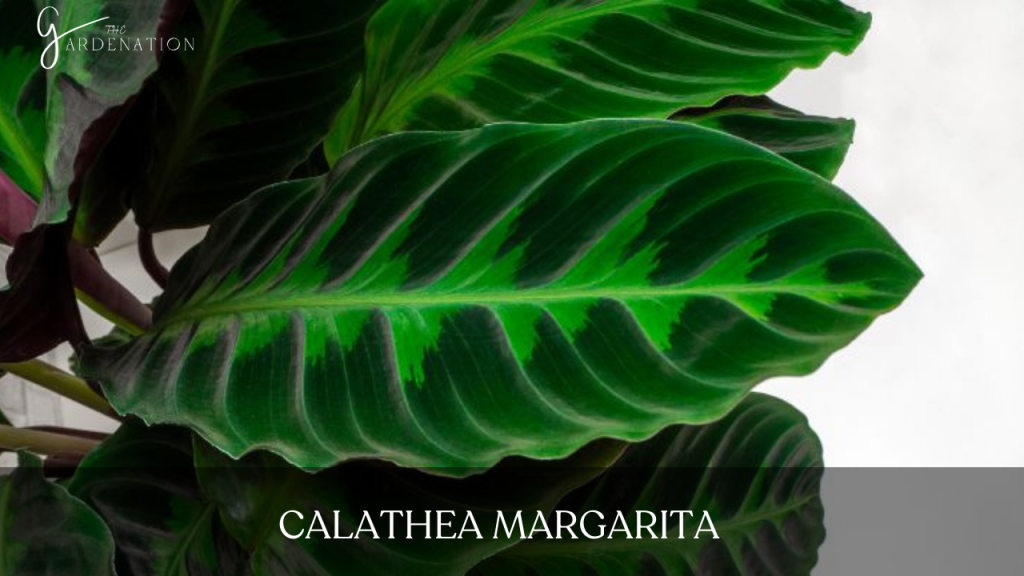
Named after daisy flowers, Calathea Margarita intrigues with elongated green leaves generously decorated by thin streaks in a graceful calligraphy-like feathered pattern. Red stems, midribs and undersides make an elegant contrast. The eye-catching leaves can span over 12 inches across at maturity.
I grow in bright filtered light avoiding direct hot sun. I maintain indoor temperatures between 65-80°F and ambient humidity levels above 50%. I provide air circulation while keeping away from cold drafts. I water when the soil surface begins drying out. I monitor closely for spider mites on undersides of new growth which can spread rapidly.
8. Calathea Lietzei ‘White Fusion’
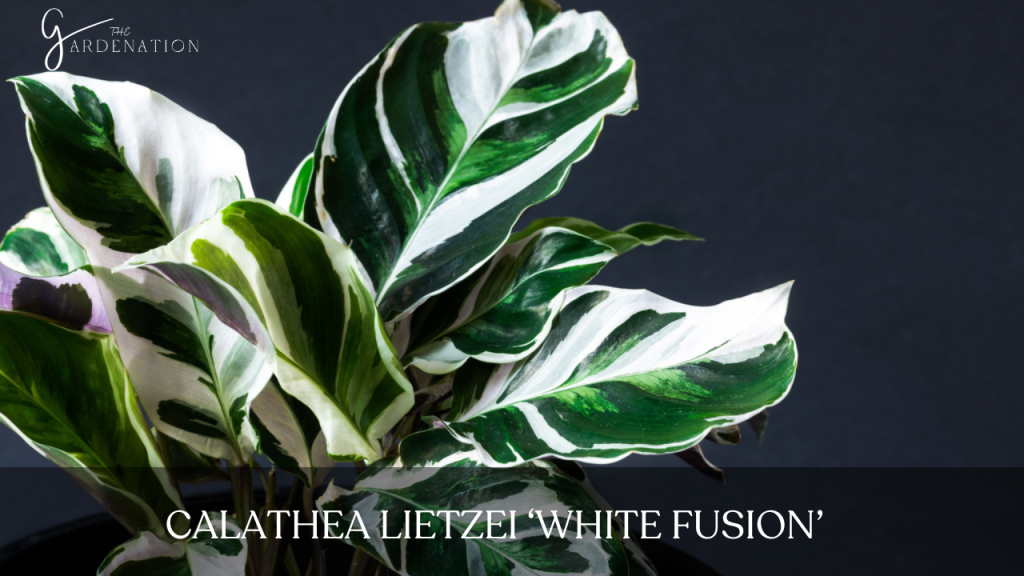
One of the few Calathea varieties where white takes the spotlight, ‘White Fusion’ lives up to its designation with striking foliage. Emerging leaves showcase a broad central white midrib. White coloration also accents the leaf margins, making a bold statement against the deep green leaf faces. Red undersides and purple stems provide tonal contrast.
I site away from direct sun which can burn delicate foliage. I provide bright indirect light instead to encourage growth. I maintain indoor temperatures between 60-75°F and stable humidity around 60% using humidifiers and trays with water pebbles. I water thoroughly allowing soil to partly dry before re-wetting. I mist occasionally to hydrate and supplement moisture levels.
9. Calathea Majestica ‘White Star’
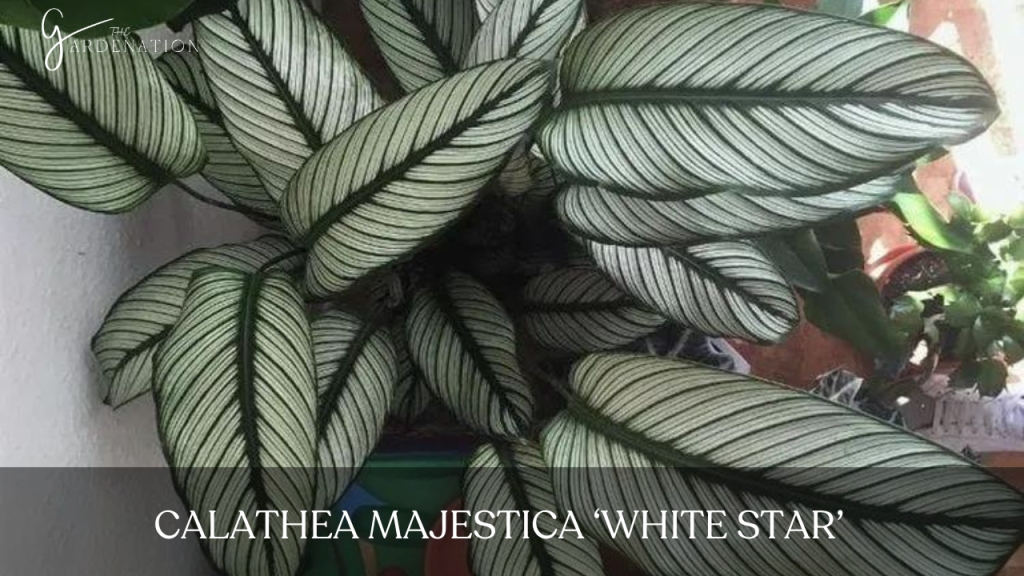
Another variety flaunting white variegated splendor, Calathea ‘White Star’ delights with glossy green leaves decorated by central white midrib streaks resembling stars. New growth flushes light green before darkening into deeper emerald tones, allowing the white accents to starkly contrast. Red stems highlight the foliage.
I grow indoors with bright filtered light and temperatures between 65-80°F. I provide supplemental humidity around 60% using humidifiers or pebble trays. I water thoroughly when soil partly dries using filtered or distilled water and reduce feeding during winter months. I site away from cold drafts and direct sun to prevent leaf scorch.
10. Calathea Warscewiczii
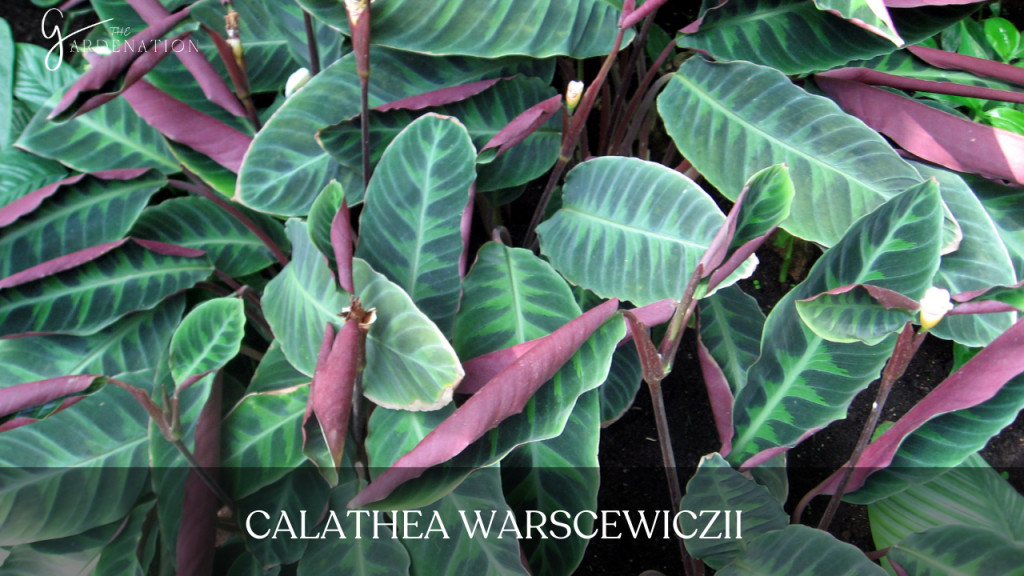
Last but not least, Calathea Warscewiczii captivates with perfectly symmetrical sets of 4 elongate leaves radiating from a central reddish-purple stem in a flower-like pinwheel. Wavy leaf edges in rich emerald green make a striking statement. This orderly arrangement adds incredibly unique texture and form to its lush tropical look.
Native to the steamy jungle floors of Bolivia and Brazil, Warscewiczii thrives when given similar conditions indoors. I provide temperatures around 70°F to 80°F and stable humidity between 50-60%. Situate in bright filtered light. I maintain consistently moist well-draining soil using rainwater or distilled water only. I feed monthly during growth seasons for strong health.
Rare Calatheas Care Tips
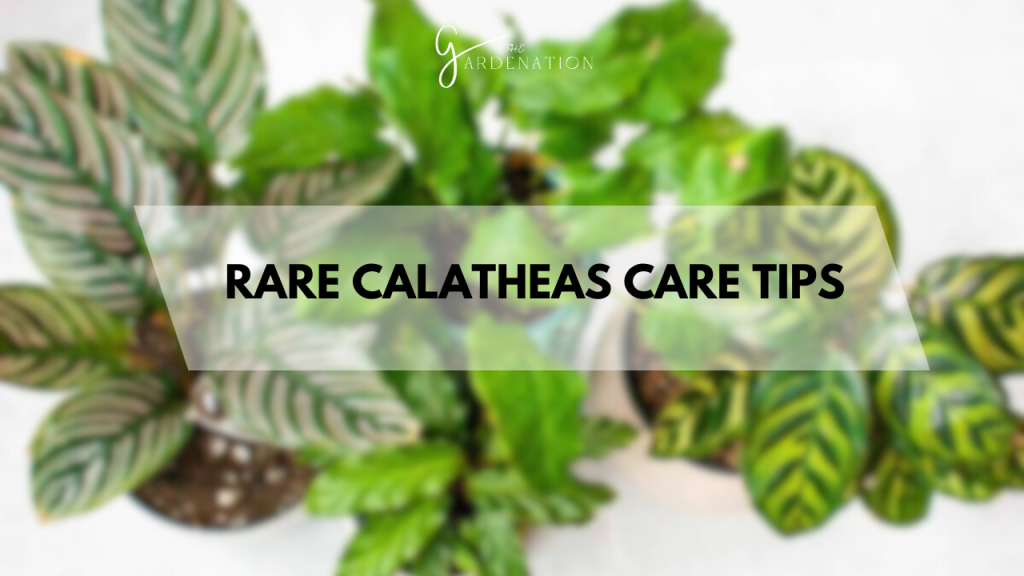
As evident in their descriptions, rare Calathea and Goeppertia plants charm yet challenge even experienced collectors. Providing suitable environmental conditions and meticulous care gives the best chances of sustained health and enjoyment. Consider the following optimal care specifications:
- Light: Bright indirect light suits most varieties. I acclimate new plants slowly and monitor for leaf burn. I keep variegated types away from direct sun to prevent scorching.
- Water: Distilled or rainwater prevents leaf tip burn. I water regularly but avoid soggy soils by using fast-draining potting mixes. Leaf curling signals underwatering.
- Temperature: Ideal ranges span 60-80°F. I monitor for cold drafts and heat stress. I consider a pebble tray or humidifier to optimize moisture.
- Soil: I use high-quality potting mixes amended with orchid bark for drainage and aeration. I try to re-pot every 2 years as needed.
- Feeding: I apply balanced liquid fertilizer at half-strength during growth seasons for nourishment. I reduce feeding in winter months.
- Toxicity: I keep plants away from drafts near fireplaces, radiators and A/C vents to prevent leaf damage from indoor pollutants.
- Propagation: I carefully divide root balls of mature plants to generate new specimens for expanding collections.
Challenges in Growing Rare Calatheas
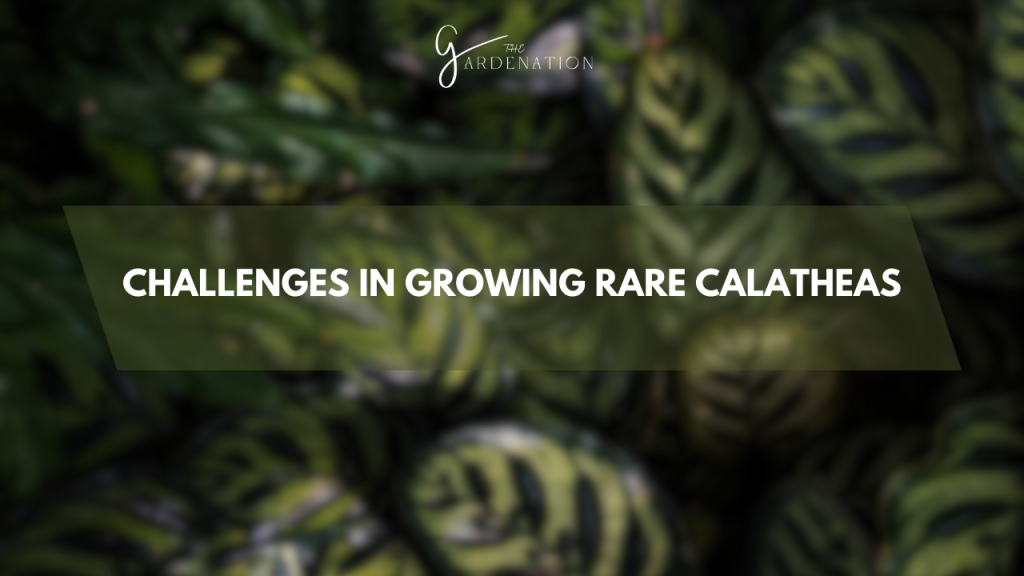
Despite one’s best efforts, issues still ambush rare Calathea collectors, especially plants moved from tropical nurseries into drastically different indoor climates. Low humidity, irregular watering, temperature extremes, pests like spider mites, and tap water chemicals frequently afflict them. Leaves may brown, curl or lose luster in distress.
When confronted by such setbacks, avoid overcorrecting. I gradually improve conditions through tweaks like misting, soil amendments and distilled water use. I seek only remedies suiting the plant’s needs instead of strong chemical interventions. With attentive observation and course corrections, most rare Calathea plants persevere.
For more information about Kitchen Gardens you can visit: Carrots Growing Stages
Long-Term Enjoyment
Successfully nurturing these capricious botanical wonders to their full glory requires exceptional dedication over months or years. Through meticulous optimizations of their growing conditions, beautiful rewards gradually unveil. Witnessing the first full unfurl of a flawless leaf or the deepening of vibrant colors brings profound satisfaction. Seeing favorites mature into showstopper statement plants delivers a lasting sense of accomplishment.
The investments of time, attention and care accorded to rare Calatheas cultivate an intimate guardian relationship. Attuning yourself to each plant’s signals and responding appropriately ties your successes together with theirs. This builds a harmonious rhythm where understanding and enjoyment compound over seasons. For the devoted plant custodian, few joys eclipse such bonds over the years.
Frequently Asked Questions
Why are Calatheas considered rare plants?
Many hobbyist collectors struggle to provide suitable care for the delicate tropical plants, limiting availability. Complex variegated leaf patterns also make commercial propagation difficult, keeping stock restricted.
Where can I buy rare Calathea varieties?
Check with specialty botanical gardens, conservatories and artisanal nurseries for availability. Establish trusted relationships with sellers ensuring correctly identified specimens. Verify suitable acclimatization and care instructions.
Why do Calatheas have such difficult care needs?
Originating in shaded Brazilian rainforests, these plants evolved for specific conditions unlike everyday indoor settings. Their sensitivity surfaces when surroundings deviate excessively. Gradual acclimatization to new environments can improve adaptability.
Conclusion
The world of rare Calatheas spans gorgeous yet temperamental plants that lavishly reward those willing to attune to their needs. I revel in their elegance but respect their limitations by providing meticulous care. Let their leafy splendor enrich your devotion as a diligent plant custodian. Soon these fickle lovelies will unfold their vibrant charms with you as their compassionate champion.

